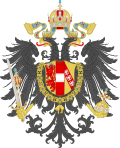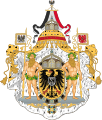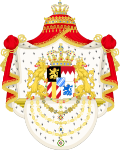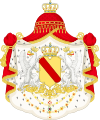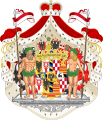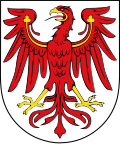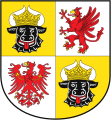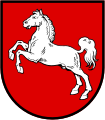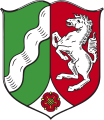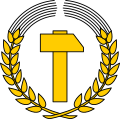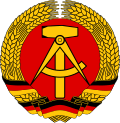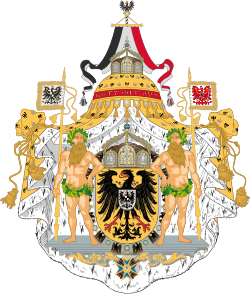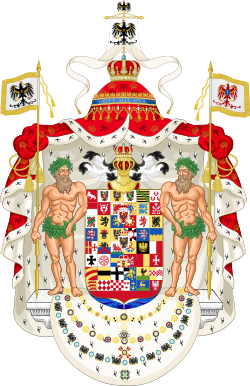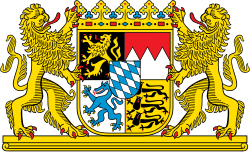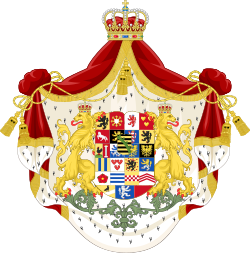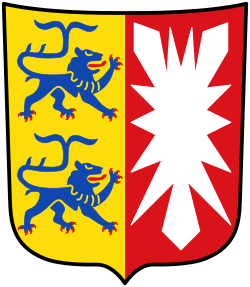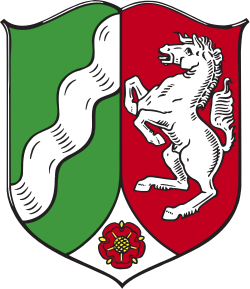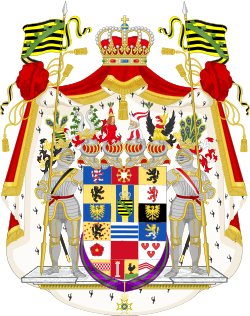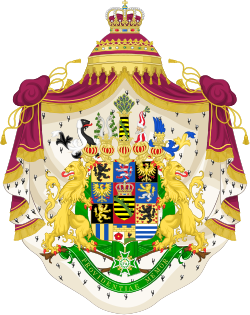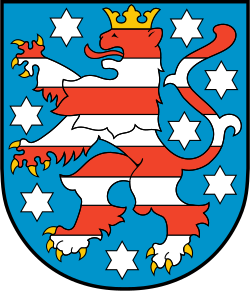Státní znak Německa
| Německý státní znak | |
|---|---|
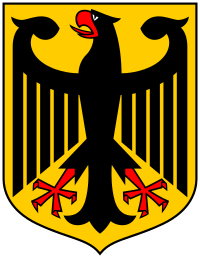 | |
| Informace | |
| Subjekty oprávněné užívat znak | |
| Přijato | 23. května 1949 3. října 1990 |
Státní znak Německa (německy též Bundesadler, tedy spolková orlice) tvoří černá orlice s červenou zbrojí na zlatém štítu. Jako znak byl přijat 20. ledna 1950 ovšem pouze Spolkovou republikou Německou (Západním Německem), pro Německou demokratickou republiku (Východní Německo) byl v té době nepřijatelný, ale jako státní znak znovusjednoceného Německa se používá od 3. září 1990. Orlici z tohoto znaku se lidově také říká Reichsadler.
Historie
Symbol černé orlice na zlatém podkladu se vyskytuje již na mincích z 12. století a patří tak k nejstarším znakům na světě. Jako znak používali nejdříve jednohlavou orlici později dvouhlavého orla císaři Svaté říše římské a jako znak této říše zůstal orel až do jejího zániku v roce 1806. Stejné symboly použili pro svůj znak Habsburkové, jelikož dlouhou dobu byli císaři Svaté říše římské a po nich tento znak převzali (či podědili) s drobnými úpravami Lotrinkové resp. Habsbursko-Lotrinská dynastie a tento dvouhlavý orel se stal v roce 1804 znakem rakouského císařství. Když v roce 1806 zanikla Svatá říše římská národa německého a jejím nástupcem se v roce 1815 stal Německý spolek, tak se jeho znakem stala právě orel podobný tomu, jejž používala Svatá říše římská národa německého.
Svata říše římská
- Původní vlajka Svaté říše římské a jejích císařů (800-1200)
- Znak Svaté říše římské
- Znak císaře Josefa II. (1765)
- Znak Rakouského císařství, jenž byl vytvořen podle znaku Svaté říše římské
Když došlo v roce 1871 ke sjednocení Německa a vytvoření Německého císařství, stala se jednohlavá orlice oficiálním znakem Německa a je od té doby ve znaku neustále. Orlice však od té doby již nikdy neměla v pařátech panovnické insignie moci jako je meč, žezlo nebo říšské jablko. Od roku 1889 se státním znakem Německého císařství resp. Německé říše stala pouze orlice, jež nebyla součástí štítu a jež nesla na prsou znak Pruska na němž byl erb vládnoucí dynastie Hohenzollernů a kolem orlice byl obtočen Řád černé orlice a nad hlavou orlice byla císařská koruna (existující jen jako heraldický model), ale orlice jí neměla na hlavě ale nad ní. Německé císařství mělo ještě velký znak i když ten byl používán zřídka nebo spíše jako znak císaře. Od malého znaku se lišil tím, že orlice byla součástí klasického zlatého štítu nad kterým byla císařská koruna (heraldický model) a kolem tohoto štítu byl obtočen Řád černé orlice a na boku stáli dva štítonoši, tzv. bájní Heráklové neboli divý mužové kteří drželi korouhve, jenž jedna byla se znakem pruska (černá orlice) a se znakem Braniborska (červená orlice). Toto celé byl součástí (císař.) stanu, jenž byl (neobvykle) zlatý s tinkturou černých orlic na jehož vrcholu byla další císařská koruna a korouhev s vlajkou Německého císařství.
Revoluce 1848, Německý a Severoněmecký spolek
- Znak Rakouského císařství, jenž byl předlohou pro znak Německého spolku
- Znak Německého spolku
- Navrhovaný znak Německého císařství za revoluce v r. 1848
- Znak Severoněmeckého spolku (1867–1871)
Po vyhlášení Výmarské republiky v roce 1918 byly všechny části znaku připomínající monarchii odstraněny (císařská koruna, řád černé orlice a štít se znakem Pruska a Hohenzollernů) a orlice se jako státní znak opět vrátila na zlatý štít. Po nástupu nacismu v roce 1933 se znakem stala opět orlice ovšem jednoduchá černá orlice, jež nesla hákový kříž. Na tradici znaku s orlicí navázalo v roce 1959 tzv. Západní Německo jenž přijal za svůj znak (graficky) jednoduchou orlici, ale pro Východní Německo byl v té době nepřijatelný, ale jako státní znak znovusjednoceného Německa se stejný znak s orlicí jaký používalo Západní Německo používá od 3. září 1990.
Znaky sjednoceného německa
- Provisionální znak Německého císařství (r. 1871)
- Státní znak Německého císařství (1871–1889)
- Státní (malý) znak Německého císařství (1889–1918)
- Velký státní znak Německého císařství resp. císaře (1889–1918)
- Státní znak Výmarské republiky (1918–1933)
- Státní znak za Třetí říše (1933–1945)
- Současný státní znak (od 1990)
- Verze znaku užívaná na služebních vlajkách
- Standarta spolkového prezidenta
Znaky spolkových zemí
Znaky spolkových zemí Německého císařství
- Znaky království
- Znaky velkovévodství
- Meklenbursko-zvěřínské velkovévodství
- Znaky vévodství
- Znaky knížectví
- Reuss starší i mladší linie (stejný znak)
- Schwarzburg (obě knížectví)
- Waldeck a Pyrmont
- Znaky Svobodných měst
Znaky zemí Spolkové republiky Německo
- Svobodný stát Bavorsko
- Svobodný stát Sasko
- Svobodný stát Durynsko
- Země Hesensko
- Země Braniborsko
- Země Dolní Sasko
- Země Porýní-Falc
- Země Sársko
- Země Sasko-Anhaltsko
- Země Šlesvicko-Holštýnsko
- Země Berlín
- Svobodné hanzovní město Brémy
- Svobodné a hanzovní město Hamburk
Státní znak Německé demokratické republiky
Státní znak NDR byl tvořen kruhovým červeným polem se zlatým kladivem a kružítkem. Kolem kruhu byl věnec zlatých pšeničných klasů, obtočených stuhou v německých národních barvách (černá, červená, žlutá). Kladivo symbolizuje dělníky, kružítko inteligenci, pšeničné klasy rolníky.
- První verze (1950–1953)
- Druhá verze (1953–1959)
- Třetí verze (1959–1989)
Odkazy
Související články
Externí odkazy
 Obrázky, zvuky či videa k tématu Státní znak Německa na Wikimedia Commons
Obrázky, zvuky či videa k tématu Státní znak Německa na Wikimedia Commons
Média použitá na této stránce
Blasonierung nach Ströhl:
Das Grössere Wappen Sr. Majestät des Deutschen Kaisers zeigt den deutschen Reichsadler preussischen Wappenschild, dessen Adler mit dem Schilde von Hohenzollern belegt ist im goldenen Schilde, der über sich die deutsche Reichskrone trägt. [...] Um den Schild schlingt sich die Kette des Hohen Ordens vom Schwarzen Adler. [...] Der Schild, der auf einem steinernen Postamente aufruht, wird von zwei mit Eichenlaub bekränzten und umgürteten, wilden Männern als Schildhalter beseitet, von denen jeder eine goldbefranste, und mit goldenen Schnüren gezierte, nach außen abfliegende Standarte an goldener Lanze trägt. Die Standarte des rechts stehenden Schildhalters zeigt die Wappenfigur des Schildes, mit welcher die Herzstelle des Reichsadlers belegt ist, den Adlerkopf zur Stange gewendet. Die Standarte des linken Schildhalters trägt das Wappenbild des Markgraftums Brandenburg, dessen Adler mit dem Schilde des Burggraftums Nürnberg belegt ist.
Ueber dem Wappen erhebt sich das kuppelförmige, mit Hermelin ausgeschlagene und gefütterte, mit goldenen Schnüren aufgebundene Kaiserzelt aus Goldbrokat, mit schwarzen, rotbewehrten Adlern und goldenen Reichskronen abwechselnd gemustert. Ein purpurroter Reif, von dem goldbequastete, mit weissen Tafelsteinen belegte Goldlätze herabfallen, umschliesst die Kuppel und trägt in goldenen Lettern die preussische Devise: «GOTT MIT UNS».
Auf dem Gipfel des Zeltes ruht die Reichskrone über die das Nationalbanner hervorragt. Es hängt an einer goldenen Querstange mit Kronenenden, werlche Stange wieder an einem, in den preussischen Farben (Schwarz - Silber) gestreifen Maste befestigt ist, der auf seinem Kronenende den preussischen Adler trägt. Die Farben des in der Mitte geschlitzten und in Quasten endigenden Nationalbanners sind Schwarz-Silber-Rot.
— Hugo Gerhard Ströhl, in: Ströhl, Hugo Gerard (1897) (němčina) Deutsche Wappenrolle. Enthaltend alle Wappen, Standarten, Flaggen, Landesfarben und Kokarden des Deutschen Reiches, seiner Bundesstaaten und regierenden Dynastien. Nach offiziellen Angaben gezeichnet und erläutert, Stuttgart: J. Hoffmann, pp. 1
Autor: Glasshouse, using elements by Sodacan, Katepanomegas and Regicollis, Licence: CC BY-SA 4.0
Coat of Arms of the Kingdom of Prussia 1873-1918
Coat of arms of Brandenburg. Argent, an eagle gules, beaked, armed, clover-stemmed or.
Autor: Sodacan, Licence: CC BY-SA 3.0
Imperial Coat of Arms of the Empire of Austria, used from 1815 to 1866.
Staatswappen der DDR (12. Januar 1950 – 28. Mai 1953)
Kleines Wappen des Deutschen Kaisers 1871-1889
Great national coat of arms of Free and Hanseatic City of Hamburg
Autor: Glasshouse using elements by Sodacan, Heralder and Trondivers, Licence: CC BY-SA 4.0
Coat of Arms of the Grand Duchy of Hesse 1806-1918
Autor: Glasshouse using elements by Sodacan, Trondivers and katepanomegas, Licence: CC BY-SA 4.0
Coat of Arms of the Duchy of Saxe-Coburg and Gotha
Autor: Glasshouse, Licence: CC BY-SA 3.0
The coat of arms of the Kingdom of Württemberg adopted by King Wilhelm I on December 30, 1817.
Autor: Glasshouse, using elements by Sodacan, Trondivers, Licence: CC BY-SA 4.0
Coat of Arms of the Grand Duchy of Mecklenburg - Schwerin
Coat of Arms of East Germany from 1953-1955. I used Coat of arms of East Germany.svg and removed the red background, rotated the compass and made a few minor alterations, Vlastní tvorba založená na: DDR2.PNG.
Coat of arms for Bremen's state flag
Autor: Glasshouse using elements by Sodacan, Trondivers and katepanomegas, Licence: CC BY-SA 4.0
Coat of Arms of the Grand Duchy of Saxe-Weimar-Eisenach
Autor: Glasshouse, Licence: CC BY-SA 4.0
Coat of Arms of the Principality of Lippe
Autor: Tom Lemmens (in collaboration with Heralder), Licence: CC BY-SA 3.0
Greater Coat of Arms of Joseph II, Holy Roman Emperor
Autor: Glasshouse using elements by Sodacan and Trondivers, Licence: CC BY-SA 4.0
Coat of Arms of the Duchy of Saxe-Altenburg
Autor: Glasshouse, Licence: CC BY-SA 4.0
Coat of Arms of the Principality of Schwarzburg-Sondershausen. These arms differ from Schwarzburg-Rudolstadt in that the crest bears a princely hat and the base field is Or.
Autor: Glasshouse with elements by Sodacan, Tom-L and katepanomegas, Licence: CC BY-SA 4.0
Coat of Arms of the Principality of Waldeck and Pyrmont
Autor: Tento vektorový obrázek byl vytvořen programem Inkscape ., Licence: CC BY-SA 3.0
Coat of arms of the North German Confederation.
Autor: Glasshouse using elements by Sodacan, Tom-L and Katepanomegas, Licence: CC BY-SA 4.0
Coat of Arms of the Principality of Reuss-Greiz, Younger line. These arms differ from those of the Principality of Reuss-Greiz, Older Line, in that the lion supporters are black and white
Autor: Glasshouse using elements by Sodacan, Licence: CC BY-SA 4.0
Coat of Arms of the Principality of Schaumburg-Lippe
Autor: Jacques63, Licence: CC BY-SA 3.0
Coats of arms Grand Duché d Oldenbourg
Autor: Glasshouse, using elements by Sodacan, Licence: CC BY-SA 4.0
Coat of Arms of the Grand Duchy of Baden 1877-1918
Autor: David Liuzzo, Licence: CC BY-SA 3.0
Wappen(entwurf) des Deutschen Reiches nach dem Gesetz vom 12. November 1848.
Autor: Glasshouse, using elements of Sodacan, Trondivers and Avalokitesvara, Licence: CC BY-SA 4.0
Coat of Arms of the Duchy of Saxe-Meiningen-Hildburghausen
Provisorisches Wappen des Deutschen Reichs hergestellt anlässlich der Proklamation in Versailles.
Autor: Glasshouse, using elements by Sodacan and Trondivers, Licence: CC BY-SA 4.0
Coat of Arms of the Grand Duchy of Mecklenburg - Strelitz
Autor: Glasshouse, using elements by Sodacan, Trondivers and katepanomegas, Licence: CC BY-SA 4.0
Coat of Arms of the Kingdom of Saxony 1806-1918
Coat of Arms of the Kingdom of Bavaria 1835-1918
The Imperial Eagle or Emblem of the German Empire (German Reich, used 1935–1945), which features an eagle looking over its right shoulder, that is, looking to the left from the viewer's point of view. It is similar to the Parteiadler or Emblem of the Nationalsozialistische Deutsche Arbeiterpartei (NSDAP; known in English as the National Socialist German Workers' Party, or simply the Nazi Party), but the eagle of the latter is looking over its left shoulder, that is, looking to the right from the viewer's point of view.
Autor: Jaume Ollé; svg version by Masur, Licence: CC BY-SA 3.0
Vlajka Svaté ríše rímské pred 1400.
Autor: Glasshouse with elements by Sodacan and Trondivers, Licence: CC BY-SA 4.0
Coat of Arms of the Duchy of Anhalt
Autor: Glasshouse, Licence: CC BY-SA 4.0
Coat of Arms of the Duchy of Brunswick
Autor: David Liuzzo, Licence: CC BY-SA 3.0
Arms of Germany at the beginning of the Weimar Republic. In 1928, they were replaced by the new official coat of arms
Imperial Eagle of the German Empire from 1889 to 1918.
The coat of arms of Lower Saxony. Also the former ( – 1947) coat of arms of Land Braunschweig.
Keep red shade parallel with File:Flag of Germany.svg’s red shade.
A white Saxon steed (Sachsenross) on a red background.


